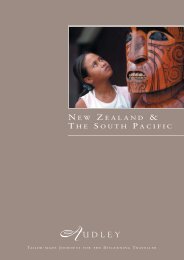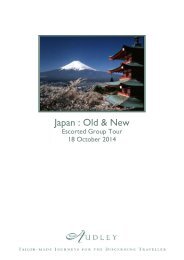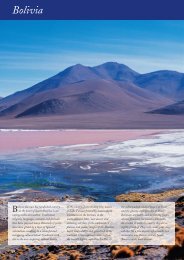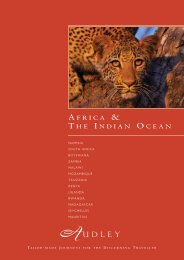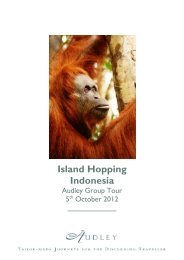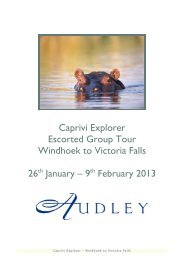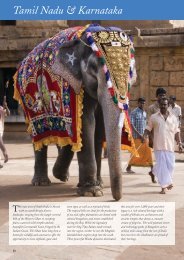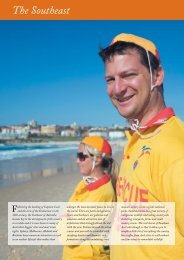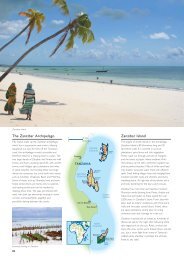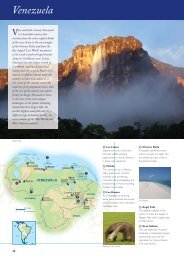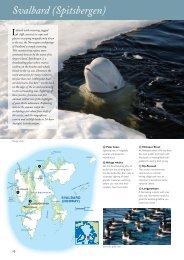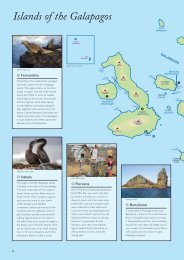01/144 front and back cover.qxd:Audley brochure ... - Audley Travel
01/144 front and back cover.qxd:Audley brochure ... - Audley Travel
01/144 front and back cover.qxd:Audley brochure ... - Audley Travel
- No tags were found...
Create successful ePaper yourself
Turn your PDF publications into a flip-book with our unique Google optimized e-Paper software.
TanzaniaTanzania contains the very best ofEast Africa’s attractions, combininglarge national parks <strong>and</strong> dense animalpopulations with pristine beaches. It is vast,vibrant <strong>and</strong> a photographer’s paradise.To the north, wildebeest <strong>and</strong> zebra floodthe Serengeti plains each year. Flamingosblanket the lakes in shimmering pinks,herds of elephants roam the savannah,<strong>and</strong> Maasai herders walk with their cattle.The snow-capped peak of MountKilimanjaro is Africa’s highest point. To thesouth lie remote reserves, where wild dogsmake dens, thous<strong>and</strong>s of buffalo graze <strong>and</strong>lakes <strong>and</strong> rivers house hippos <strong>and</strong> crocodiles.Away from the savannah, toweringmountains are entangled in thick rainforest.Emerald leaves drip with dew, birds <strong>and</strong>monkeys cackle <strong>and</strong> shrieks of chimpanzeesslice the air. Perfect for post-safarirelaxation are the tropical isl<strong>and</strong>s <strong>and</strong>colourful villages of the Zanzibar <strong>and</strong>Mafia archipelagos. Miles of white s<strong>and</strong>are flanked by coconut palms, small fishingvillages tucked underneath. Dhows sail overturquoise waters, whilst iridescent tropicalfish swim around the rich coral reefs.72
<strong>Audley</strong> in Tanzania561427Tanzania is a vast country with a dizzyingarray of options. It is impossible to seeeverything that the country has to offer inone trip, so we recommend focusing onjust one or two areas. In northern Tanzaniathe parks such as the Ngorongoro Crater<strong>and</strong> Serengeti are well known <strong>and</strong> can bebusy. Through extensive travel in this region,we have found a way to avoid othervisitors <strong>and</strong> stay in quiet areas. Whilst manyvisitors simply drive around, we give youthe freedom to explore on foot alongpaths that only the Maasai know, <strong>and</strong> tocamp in magical spots surrounded by game.3In southern Tanzania, we know the Selous<strong>and</strong> Ruaha inside-out. We have h<strong>and</strong> pickedcamps with the best locations <strong>and</strong> expertguides <strong>and</strong> can seamlessly combine all theparks with Tanzania’s beaches <strong>and</strong> isl<strong>and</strong>s.On Zanzibar we work with local guides <strong>and</strong>a small number of hotels whose owners weknow personally. Small lodges on the MafiaIsl<strong>and</strong>s <strong>and</strong> the coast of northern Tanzaniaare ideal for those looking for a reallyremote place to stay on an idyllic beach.Whatever you’d like to do in Tanzania, ourteam can tailor a trip suited to you.1 Serengeti National ParkTanzania’s most famousnational park, where the GreatMigration herds roam for mostof the year.2 Ngorongoro CraterA volcanic caldera where youcan enjoy some of the bestgame viewing in Tanzania in ashort timeframe.3 Selous Game ReserveWith Tanzania’s largest wild dogpopulation <strong>and</strong> huge herds ofelephants, this is a superb <strong>and</strong>wild area to explore on safari.Lion in the SerengetiMongoose4 Ruaha National Park 7 Zanzibar ArchipelagoAnother gem in SouthernTanzania with vast open plains,huge buffalo herds <strong>and</strong> goodlion populations.Beautiful spice isl<strong>and</strong>s withidyllic s<strong>and</strong>y beaches <strong>and</strong>accessible coral reefs forsnorkelling <strong>and</strong> diving.5 Mahale MountainsOn the shores of LakeTanganyika, rainforest-cladmountains provide a refugefor chimpanzees.6 Katavi National ParkOne of the country’s wildest<strong>and</strong> most remote national parks.LovebirdAccommodationThroughout Tanzania, we use a variety oflodges <strong>and</strong> camps, ranging in comfort butalways in a good location so that you canenjoy the wildlife <strong>and</strong> stunning views. Ourpreference is for the smaller properties,where you can be assured of personalservice <strong>and</strong> attention to detail. We can findyou an authentic safari camp in which toexperience the magic of waking to thesunrise in your tent, or if you’d prefer, aluxurious tree-top lodge. On the beach, wehave found simple cottages perched on vaststretches of white s<strong>and</strong> as well as stylishlodges on private isl<strong>and</strong>s.Find out moreFor suggested itineraries <strong>and</strong> practicalinformation about travel in Tanzania, pleasesee pages 90-91.☎www.audleytravel.comInteractive maps <strong>and</strong> features,further suggested itineraries,accommodation, climate information<strong>and</strong> articles written by our specialists.Discuss your plans with our Tanzaniaspecialists <strong>01</strong>993 838 545Tanzania 73
Sunset in the SerengetiSerengeti National ParkThe Serengeti is synonymous with stampinghooves of wildebeest, vast golden savannah plains,<strong>and</strong> some of Tanzania’s most prolific wildlife.This is Africa’s most famous <strong>and</strong> fabulous gamereserve. Subject of countless documentaries, theSerengeti does not disappoint in reality. Each year,up to two million wildebeest, zebra <strong>and</strong> gazellesnake their way across the plains following thepromise of rain, forming one of the world’sgreatest wildlife spectacles. Even without themigration, the Serengeti’s wildlife is unparalleled.Lion are practically a certainty, often seenlounging on the rocky kopjes. Cheetah pace theplains or st<strong>and</strong> atop termite mounds, <strong>and</strong> leopardlounge in the dappled shade of the sausage trees.OLAKIRA MOBILE CAMP,SERENGETI NATIONAL PARKA classic mobile safari camp, Olakira movesaround the Serengeti throughout the year inorder to be best situated for the Great Migrationherds. Large walk-in tents with proper beds,lights <strong>and</strong> en suite bathrooms with bucketshowers make this a comfortable place to restafter an exhilarating day on safari. Lunches areserved under the boughs of an acacia tree,enjoying uninterrupted views across the vastsavannah. This is one of our favourite camps,offering great food, knowledgeable guides <strong>and</strong>,most importantly, a superb location for yoursafari in the Serengeti.Olakira Mobile CampBallooning in the Serengeti74Cheetah
Bateleur eagleGame drive in the SerengetiGiraffe browsingLeopard climbing a treeNOMAD SERENGETI SAFARI CAMP,SERENGETI NATIONAL PARKWith only eight luxury tents, this specialist mobilesafari camp offers a wonderfully comfortable basefor exploring the Serengeti. Moving around thepark throughout the year to follow the migration,it is always well placed for game viewing. Thecamp provides each couple or group with aprivate guide, allowing you to plan your daysaround your interests. This is particularly usefulfor keen photographers as it allows ample time forwildlife photography. In the evenings, stories of theday’s adventures are shared around the campfirebefore a hearty dinner under the African sky.KLEIN’S CAMP, SERENGETINATIONAL PARKBordering the northeastern edge of the Serengeti,Klein’s camp sits on a hillside overlooking thevalleys <strong>and</strong> plains that stretch to the Kenyanborder. With only ten thatched chalets, this isone of the smallest <strong>and</strong> most exclusive camps inthe park. It offers guests the chance to explorenot only on daytime game drives, but also nightdrives <strong>and</strong> guided walks in the camp’s privatereserve. The area is superb for elephant <strong>and</strong> largebuffalo herds, <strong>and</strong> really comes into its ownduring July <strong>and</strong> October when the migrationherds pass through.Sayari CampNomad Serengeti Safari CampSAYARI CAMP, SERENGETINATIONAL PARKOverlooking the Mara River in the far north ofthe Serengeti, Sayari has a comm<strong>and</strong>ing position<strong>and</strong> sweeping views. The luxurious tents are vast,based on wooden platforms, <strong>and</strong> stylishlydesigned with real attention to detail, down tothe cosy daybed on your balcony, just perfect forrelaxing <strong>and</strong> enjoying the wildlife as it w<strong>and</strong>erspast. This area of the national park is quiet <strong>and</strong>unspoilt, allowing you to enjoy the wildlife withonly the sounds of birds to disturb you. It’s a verytranquil place to stay <strong>and</strong> ideal for those lookingto really get away from it all.Klein’s Campwww.audleytravel.com/tanzania ● <strong>01</strong>993 838 545 ● Tanzania 75
The Great MigrationMigrating zebra <strong>and</strong> wildebeestThe savannah plains stretching from Kenya’sMasai Mara to Tanzania’s Serengeti set the scenefor one of the world’s greatest wildlife spectacles;the annual migration of more than two millionwildebeest, zebra <strong>and</strong> gazelle. Lion, leopard,cheetah <strong>and</strong> hyena wait in great anticipation forthe arrival of the herds, ready to single out aweak or vulnerable animal for an easy dinner.This is the Africa that wildlife documentaries aremade of, <strong>and</strong> no matter whether you have beenon one or a dozen safaris, there is little tocompare to the spectacle of the migrationherds <strong>and</strong> the drama that surrounds them.Practicalities for your GreatMigration safariThe migration can either be viewed from Kenyafrom about July to October or Tanzania fromNovember to June. Although you may think itJackal on a wildebeest killGame driving amongst the herdswould be difficult to miss two millionwildebeest, sightings of the migration herds cannever be guaranteed as the herds’ movementsdepends on their biological clock, the level ofgrazing, <strong>and</strong> timing <strong>and</strong> amount of rainfall.Whilst they follow a rough annual pattern it canchange all the time. That said, our team knowsthe parks well <strong>and</strong> can choose camps in thecorrect location to maximise your chances offinding the herds.Mobile campsStaying in one of the Serengeti’s mobile safaricamps is one of the best ways to see themigration. Moving every couple of months tolocate themselves as close as possible to theherds, these camps offer the best chance offinding them during your safari. Due to theimpermanent nature of the camps, don’texpect the ultimate luxury. This is all about anauthentic safari experience <strong>and</strong> getting as closeas you can to the wildlife. Your tent will have acomfortable bed, en suite bathroom with abucket shower, a basin with a jug of warm watereach morning <strong>and</strong> evening <strong>and</strong> hurricane lampsat night. As well as giving you an excellentlocation, sleeping under canvas <strong>and</strong> waking tothe sunrise is one of the best ways to enjoy themagic of the Serengeti.River crossingsThe wildlife documentaries make watching ariver crossing look easy. In reality, filmmakersspend months <strong>and</strong> even years waiting to be inthe right place at the right time to capture themoment. Whilst seeing a river crossing is reallythe icing on the cake for most safari-goers, it’simportant to be aware that the herds oftenspend weeks at the riverbanks contemplatingthe crossing. So unless you have endless time<strong>and</strong> money to spend waiting patiently, you willhave to rely on luck <strong>and</strong> good timing if you hopeto catch a crossing. If you want to maximise yourchances of this, we would recommend staying inthe Northern Serengeti in July, or in the MasaiMara in August or September.76
Wildebeest crossing the Mara RiverWildebeest waiting to cross the Mara RiverLion on a killThe Migration CalendarDecember to May – Breeding <strong>and</strong> CalvingThe cycle begins each year in the warm, dustyplains of the southern Serengeti, where almosthalf a million wildebeest are born betweenDecember <strong>and</strong> March. Up on their feet almostthe moment they hit the ground, they readythemselves for the greatest journey of their lives.During these months, the herds are not on themove, but are gathering strength, grazing on theNdutu Plains before the long rains arrive in April<strong>and</strong> May, turning the park green overnight.June – The Journey NorthAs June arrives <strong>and</strong> the rains cease, the herdsbegin to sweep steadily through the savannah.Long ribbons of wildebeest, zebra <strong>and</strong> gazellesnake their way through tall grass, weaving theirway towards the Grumeti River. Here, enormouscrocodiles lie in wait, snapping their jaws on theriverbanks, a terrifying prospect for the herdsto overcome.July – Crossing the Mara RiverAs the plains become increasingly parched,thous<strong>and</strong>s of stampeding hooves marchnorthwards to the Masai Mara, where the greatwall of the rift valley traps any final drops of rain.By July, the <strong>front</strong>-runners of the herds arepreparing to cross the Mara River, whilst therear-guard may be as far south as the Grumeti.The Mara River brings the herds to a halt, whilstthey contemplate their fate. Strong currents,crocodiles <strong>and</strong> hippos provide a serious obstacleto reaching the lush grass on the oppositeriverbank – this is the ultimate test for the herds.The animals can often wait for two weeks beforecrossing, approaching the river <strong>and</strong> turning <strong>back</strong>at the last moment with a kick of the heels <strong>and</strong> apuff of dust. Eventually, one brave wildebeest willtake the plunge, followed swiftly by thous<strong>and</strong>s,swimming desperately across the river.August to October – Grazing inKenya’s Masai MaraBy August <strong>and</strong> September, the migration issafely in the Masai Mara in Kenya, where thewater provides fresh grazing throughout the leanmonths of the dry season. The herds movearound the reserve, crossing the Talek <strong>and</strong> Mararivers constantly in search of water <strong>and</strong> grass.This is also a feasting time for the big cats of theMasai Mara, making it a truly exciting time to beon safari here.November – The Journey SouthNovember brings the short rains, <strong>and</strong> new life tothe grassl<strong>and</strong>s of the southern Serengeti. Thewildebeest, able to detect rain from more than50 kilometres away, return south, completing thecircle. The two million pairs of hooves thunderthrough the Loliondo, Lobo <strong>and</strong> Piaya regions ofthe Northern Serengeti until they finally reach therich volcanic soil of the Ndutu Plains once again.www.audleytravel.com/tanzania ● <strong>01</strong>993 838 545 ● Tanzania 77
Zebra in the Ngorongoro CraterNgorongoro CraterThe Ngorongoro Crater is the world’s largestintact volcanic caldera <strong>and</strong> one of the mostevocative l<strong>and</strong>marks of the Great Rift Valley. Itprovides an extraordinary natural sanctuary forsome of Africa’s densest populations of largemammals. This is the best place in Tanzania tosee black rhino, against the dramatic <strong>back</strong>drop ofthe 600 metre high crater wall. The grassy plainshost thous<strong>and</strong>s of zebra, buffalo, wildebeest <strong>and</strong>Thomson’s <strong>and</strong> Grant’s gazelle. Elephant roam theLerai Forest, <strong>and</strong> lion <strong>and</strong> leopard complete thebig five. The wildlife here has to be seen to bebelieved, <strong>and</strong> makes the Ngorongoro Crater anunmissable part of the northern safari circuit.GIBBS FARM,NGORONGORO HIGHLANDSSurrounded by coffee plantations in the heart ofthe Ngorongoro Highl<strong>and</strong>s, this is a working farmon which acres of organic fruit, vegetables <strong>and</strong>flowers are grown. Eighteen luxurious cottagesare dotted around the farm, all enjoying views ofthe lush vegetation <strong>and</strong> tropical flowers. Each hasbeen tastefully decorated with bright Africanfabrics, fireplaces to ward off cool evenings <strong>and</strong>spacious bathrooms with outdoor showers.Aside from visits to the Crater there are plentyof activities ranging from walks in the forests tovisits to local Iraqw villages.PLANTATION LODGE,NGORONGORO HIGHLANDSPlantation Lodge is a charming small propertytucked away in the Ngorongoro Highl<strong>and</strong>s nearthe colourful village of Karatu. There are 16rooms spread out amongst the pretty gardens,<strong>and</strong> all are spacious <strong>and</strong> comfortable. The staff arefriendly <strong>and</strong> welcoming, <strong>and</strong> the swimming pooloffers a lovely place to relax when you’re not outon safari. Food is tasty <strong>and</strong> home-cooked, <strong>and</strong>both the Ngorongoro Crater <strong>and</strong> Lake Manyaraare easily accessible as day trips from the lodge.NGORONGORO CRATER LODGE,NGORONGORO CRATEREasily one of East Africa’s most luxurious safarilodges, the Ngorongoro Crater Lodge has acomm<strong>and</strong>ing position perched on the edge ofthe crater rim. The twelve lavish suites in North<strong>and</strong> South camp <strong>and</strong> the six suites in Tree Campare fitted with antique furniture, thick rugs,ch<strong>and</strong>eliers <strong>and</strong> claw footed baths in oak panelledbathrooms. Each suite is complete with a personalbutler to light the fire, put fresh water in theflowers <strong>and</strong> serve drinks. The views from everysuite <strong>and</strong> the opulently designed dining roomsare simply breathtaking.The pool at Plantation Lodge78The dining room at Ngorongoro Crater Lodge
Black rhino in the Ngorongoro CraterFlamingos on Lake ManyaraGame drive in Tarangire National ParkLake Manyara Tree LodgeManyara National ParkOne of Northern Tanzania’s smallest but prettiestnational parks, Lake Manyara is situated at thebase of the Rift Valley Escarpment. The alkalinelake is often <strong>cover</strong>ed in clouds of pink lesserflamingos, <strong>and</strong> is surrounded by marshl<strong>and</strong>where hippos <strong>and</strong> buffalo wallow in the shallows.The diversity of vegetation here is remarkable,with grassy floodplains, acacia woodl<strong>and</strong> <strong>and</strong>hot springs. Manyara is most famous for itstree-climbing lions, but has plenty of other wildlifeto enjoy too, including prolific elephant, buffalo,zebra <strong>and</strong> giraffe. Birdlife here is also superb, withalmost 400 recorded species including iridescentbee-eaters <strong>and</strong> silvery-cheeked hornbills.LAKE MANYARA TREE LODGE,MANYARA NATIONAL PARKTucked away in the lush forest, this small luxuriouslodge is the only accommodation within the park.Guests stay in one of ten treehouses, sitting highin the mahogany trees, with large ver<strong>and</strong>ahs,polished hardwood floors <strong>and</strong> pure cotton linen.Service <strong>and</strong> food here are excellent, withsumptuous meals eaten by c<strong>and</strong>lelight in the openair boma. This is one of our favourite properties inTanzania <strong>and</strong> is certainly a highlight for any safari.LovebirdsOliver’s CampDwarf mongoose in TarangireTarangire National ParkTarangire really comes to life in the dry season,with water-seeking wildlife attracted to theabundant Tarangire River. The most impressiveof the migratory mammals is the elephant, whichcongregates in large herds along the riverbanks –it is possible to see more than 500 in a day.Buffalo, zebra, wildebeest, giraffe, el<strong>and</strong> <strong>and</strong> impalaare all found in good numbers on the grassyplains <strong>and</strong> the lush swamps are a year-roundattraction, particularly for birdwatchers, withmore than 550 recorded species. Ancient baobabtrees dot the plains <strong>and</strong> in the distance, the OlDoinyo L’Engai volcano makes a dramatic<strong>back</strong>drop for photographers.OLIVER’S CAMP, TARANGIRENATIONAL PARKLocated in the heart of Tarangire, Oliver’sCamp offers an excellent base for explorationof the park. With just eight luxury tents, this is asmall <strong>and</strong> intimate camp where guests enjoydining under the stars <strong>and</strong> waking as the sun risesover the park. As well as game drives, guidedwalking safaris can also be arranged to fullyexplore this stunning park. The mess tent is fullof comfortable chairs <strong>and</strong> a cup of hot tea or aglass of ice-cold gin <strong>and</strong> tonic is always on h<strong>and</strong>after a long day on safari.www.audleytravel.com/tanzania ● <strong>01</strong>993 838 545 ● Tanzania 79
Lion in a treeThe Selous Game ReserveThe Selous stretches for over 45,000 squarekilometres. It is Africa’s largest game reserve yetvisited by few. Me<strong>and</strong>ering through the plains<strong>and</strong> woodl<strong>and</strong>s, the Rufiji River gives rise to alabyrinth of streams, channels <strong>and</strong> pretty lakes ina delicate water paradise. Skeletal leadwoodtrees st<strong>and</strong> in glassy lagoons where terrapinsripple the surface. There are pods of hippo,rainbow-coloured birds <strong>and</strong> flitting butterflies onyellow cassia flowers. It is a vast wilderness area<strong>and</strong> superb for photography. The reserve is hometo abundant game, with Africa’s largest buffalo<strong>and</strong> lion populations, numerous leopard <strong>and</strong>thriving packs of wild dog. Wildebeest, zebra,impala, hartebeest, greater kudu <strong>and</strong> el<strong>and</strong> areall common. In the heat of the afternoon, herdsof over fifty giraffe drink from the lakes whilstelephant herds cross the channels to the lushisl<strong>and</strong>s. Boat trips are a speciality in the Selous<strong>and</strong> floating quietly along on the water is magical.You will see yellow-billed storks nesting inborassus palms <strong>and</strong> white-crowned ploverscleaning the teeth of crocodiles. The riverineforest is perfect for gentle rambles in search ofblue samango monkeys <strong>and</strong> black <strong>and</strong> whitecolobus. Driving in open 4x4’s you will seeplenty of game but no other vehicles, as theSelous is a very peaceful park with only ah<strong>and</strong>ful of small camps.80Selous Impala CampLAKE MANZE CAMP, SELOUSGAME RESERVEThis camp has 12 simple tents on the shoresof Lake Manze. Shaded by doum palms <strong>and</strong>terminalia trees, all are well spread out <strong>and</strong>have lake views. Inside, each tent is furnishedwith double or twin beds <strong>and</strong> has an en suitebathroom with flush toilet <strong>and</strong> hot shower.A patio at the <strong>front</strong> of each room is the perfectspot for reading a book in the early afternoon<strong>and</strong> watching the hippos <strong>and</strong> herons at thelakeshore. The camp is ideal for first time visitorsto Africa as guests can enjoy a variety of activitiesincluding game drives, boat safaris <strong>and</strong> earlymorning walks.SELOUS IMPALA CAMP, SELOUSGAME RESERVESelous Impala Camp is set among borassus palms<strong>and</strong> tamarind trees on the banks of the RufijiRiver. As there are no fences, game is free tow<strong>and</strong>er through the camp <strong>and</strong> therefore guestsare escorted to their tents in the evenings byMaasai warriors. The camp has eight luxury tentsset on high wood decking with views of the river<strong>and</strong> the forest beyond. They are furnished in acolonial style <strong>and</strong> have bedrooms, a dressingroom <strong>and</strong> an en suite bathroom. In the centre ofcamp the thatched boma houses a dining room<strong>and</strong> bar. Nearby is a sheltered swimming pool.Activities include boat trips, game drives <strong>and</strong>walking safaris.Game drive from Lake Manze Camp
Kudu in the SelousHyena on a buffalo carcassHippo beside the Rufiji RiverDining at Beho BehoElephant in the SelousSelous Safari CampSELOUS SAFARI CAMP, SELOUSGAME RESERVESelous Safari Camp was one of the first campsin the Selous <strong>and</strong> has one of the prime positionsin the park on the fringes of Lake Nzelekela.The 12 luxurious tents are some of the largestin Africa, tailored specifically for the camp withhuge gauze windows looking onto the lake.Inside, the tents are elegantly furnished <strong>and</strong> havewell-appointed en suite bathrooms with outdoorshowers. The lounge <strong>and</strong> dining room are raisedabove the trees on stilts to maximise the breezein hotter months <strong>and</strong> there is a small pool tuckedinto the bush. With plenty of activities on offer,this is one of our favourite camps in the Selous.BEHO BEHO CAMP, SELOUSGAME RESERVESet up amongst the hills, Beho Beho has a uniquevantage point overlooking the Beho Beho Plains.It is the most luxurious camp in the Selous withlarge stone cottages beautifully designed <strong>and</strong>furnished with no expense spared. At the <strong>front</strong>of each cottage a huge open window has nogauze or glass – just panoramic views. Guests canchoose to leave this open to the stars at night orhave thick canvas drapes tied down to feel moresecure. The true magic of Beho Beho however isnot the lodge but the exceptional quality of theguides. After each game drive you’ll come awayknowing something new.Boat trip from S<strong>and</strong> RiversView from a room at S<strong>and</strong> RiversSAND RIVERS, SELOUSGAME RESERVEWith eight rooms, S<strong>and</strong> Rivers is the smallestcamp in the Selous. Situated on a wide curve inthe Rufiji River, all the rooms look over the water.Each room is open on one side <strong>and</strong> has largebeds, nets <strong>and</strong> en suite bathrooms with polishedstone floors. It’s not unusual for birds to flit in<strong>and</strong> out <strong>and</strong> look at themselves in the bathroommirror. During a stay at S<strong>and</strong> Rivers, a privateguide is always provided. You can take a boat tripup to Steigler’s Gorge, walk on the open plains,swim in the Tagalala hot springs <strong>and</strong> enjoy tripsby open 4x4 vehicles.www.audleytravel.com/tanzania ● <strong>01</strong>993 838 545 ● Tanzania 81
Zebra on the plainsThe Ruaha National ParkIn the heart of southern Tanzania, the RuahaNational Park has a hot dry climate <strong>and</strong>dramatic scenery. The Ruaha River runs alongthe park’s southeast border, tumbling overboulders <strong>and</strong> flanked by riparian woodl<strong>and</strong>. Lioncan be seen stretched out in the sun on thes<strong>and</strong>banks, elephant drink from the water.Flocks of yellow-collared lovebirds swoop frombush to bush. Game is prolific with manyungulates present, including impala, waterbuck,bushbuck, giraffe, zebra <strong>and</strong> buffalo. Both greater<strong>and</strong> lesser kudu are here, as are roan <strong>and</strong> sableantelope. There are large prides of lion, spotted<strong>and</strong> striped hyena, several packs of wild dog, <strong>and</strong>leopard. The birdlife is particularly colourful <strong>and</strong>it is not unusual to spot many species whilesitting in camp, such as emerald spotted doves,brown parrots <strong>and</strong> crested barbets. Activities inRuaha focus on game drives although walkingis also possible.Kwihala82MWAGUSI CAMP, RUAHANATIONAL PARKMwagusi Camp is a small tented camp on thebanks of the dry Mwagusi River. Owned <strong>and</strong> runby naturalist Chris Fox, this camp is comfortablebut the focus is not on frills <strong>and</strong> luxury. Chris’spassion is for wildlife <strong>and</strong> this is what this camp isall about – it’s ideal for experienced safari h<strong>and</strong>s<strong>and</strong> animal enthusiasts. The nine tents are shadedby thatch <strong>and</strong> have beds, nets, en suite bathrooms<strong>and</strong> ver<strong>and</strong>as with comfy chairs. It is lovely sittingon your ver<strong>and</strong>a <strong>and</strong> watching the birds hoppingabout in the trees above you. Activities are wellorganised at Mwagusi with both guides <strong>and</strong>spotters on the game viewing vehicles, <strong>and</strong>guiding of a high st<strong>and</strong>ard.KWIHALA, RUAHANATIONAL PARKKwihala offers luxury in Ruaha, <strong>and</strong> has sixspacious safari tents. There are plenty of charmingsmall touches in the tents, from the h<strong>and</strong>-printedbaobab bedspreads to beaded door h<strong>and</strong>les.Outside, a <strong>cover</strong>ed ver<strong>and</strong>a area is insect-proofed<strong>and</strong> protected from the elements by a fly sheet.The spacious mess tent is the main social centre ofthe camp. Separate dining <strong>and</strong> relaxing areas createa homely feel although canvas walls <strong>and</strong> open sidesleave you with no doubt that you’re in the bush.With good guides this camp is ideal for thoselooking to explore Ruaha from a comfortable base.Mwagusi CampMDONYA OLD RIVER CAMP,RUAHA NATIONAL PARKThis wild camp has 11 tents situated undersycamore fig <strong>and</strong> acacia trees. With no electricity,it has the feel of an original safari camp, <strong>and</strong> is litat night by c<strong>and</strong>les, paraffin lamps <strong>and</strong> a camp fire.The dining <strong>and</strong> lounge tents overlook a dry riverbed which acts as a busy wildlife corridor. Thereare currently two prides of lion living close tocamp which can often be heard at night – thiscamp is not therefore suited to nervous travellers.Mdonya Old River Camp
Chimpanzee with baby in the Mahale MountainsChada CampKatavi National ParkDeep in western Tanzania, the Katavi NationalPark is extremely wild. Arriving by light aircraft,you’ll pass over the Katasunga Plains beforel<strong>and</strong>ing. Spread out before you are yellowgrassl<strong>and</strong>s <strong>cover</strong>ed with thous<strong>and</strong>s of zebra,topi, buffalo <strong>and</strong> giraffe. Lions lie on the fringes,watching <strong>and</strong> waiting, shaded by mahogany trees.With only two tiny camps in a million acres,Katavi sees few visitors <strong>and</strong> you can have animmense wilderness all to yourself. Katavi is aclassic dry season reserve. From June to October,buffalo herds of up to 3,000 graze on the plains.Game drives offer superb photographicopportunities whilst walks beside sluggish riversare exciting, with large crocodiles hiding inmudholes. As the sun falls low in the sky, a visitto the hippo pool, where 600 hippos live, isperfect for a sundowner.CHADA CAMP, KATAVINATIONAL PARKChada Camp is hidden by sausage trees <strong>and</strong>overlooks the plains. The six safari tents have highbeds, simple furniture <strong>and</strong> are decked with brightEast African fabrics. Outside each, there is asimple tin basin <strong>and</strong> small washst<strong>and</strong>. A little waybehind each tent is a private bathroom, made ofreed, sticks <strong>and</strong> soft grass. The main dining areais under canvas <strong>and</strong> strewn with books, maps,seedpods <strong>and</strong> a big chest full of drinks. Notfenced, it’s wonderfully wild <strong>and</strong> old-fashioned.Accompanied by top guides, both walks <strong>and</strong>drives are excellent.Mahale Mountains ParkShadowing the dusky blue waters of LakeTanganyika, the Mahale Mountains are dramatic<strong>and</strong> imposing. Jagged peaks of over 2,000 metressoar into the clouds <strong>and</strong> are <strong>cover</strong>ed in canopywoodl<strong>and</strong> <strong>and</strong> thick montane forest. Shafts ofsunlight pour through the trees into tiny gullieswhere pink <strong>and</strong> yellow butterflies flit <strong>and</strong> you cansee each <strong>and</strong> every pebble in the crystal clearstreams. The Mahale Mountains are the bestplace in Africa in which to track <strong>and</strong> observe wildchimpanzees. There is a population of around1,000; one troop of which, the Mimikire clan(around 70-100 individuals), have been habituatedto humans <strong>and</strong> can be tracked <strong>and</strong> observed fromclose quarters. Climbing up the leafy tracks in themisty morning <strong>and</strong> hearing your first chimpanzeeshriek is something you will never forget.Crouching low, you can watch them grooming,drinking <strong>and</strong> playing. After a morning ofchimpanzee tracking you return to the shores ofLake Tanganyika, where sugar-white beaches slopeinto gin-clear waters. There are over 500 speciesof cichlid fish in the lake, <strong>and</strong> snorkelling <strong>and</strong>floating amongst them is the ultimate in relaxation.GREYSTOKE CAMP,MAHALE MOUNTAINSGreystoke Camp is situated on an idyllic whitebeach on the shores of Lake Tanganyika. Creamsafari tents under palms have deep chairs, comfybeds, tin washbasins <strong>and</strong> buckets for washing thes<strong>and</strong> off your feet. At sunrise your breakfast iscooked over a fire on the beach, after whichtrackers lead you into the forest in search ofchimpanzees. In the afternoons you can snorkelfrom the camp’s beautiful dhow or enjoy asnooze on the warm deck.The dining room at Greystoke Campwww.audleytravel.com/tanzania ● <strong>01</strong>993 838 545 ● Tanzania 83
Zanzibar beachThe Zanzibar ArchipelagoFifty isl<strong>and</strong>s make up the Zanzibar archipelago,which lies in aquamarine seas under a blazingequatorial sun. Just 20 miles off the Tanzaniancoast, the archipelago is easily accessible <strong>and</strong>therefore ideal for a relaxing end to a safari. Thetwo large isl<strong>and</strong>s of Zanzibar <strong>and</strong> Pemba are wellknown <strong>and</strong> have a bustling isl<strong>and</strong> life, with ancienttowns, small villages, spice plantations <strong>and</strong> milesof s<strong>and</strong>y beaches. Surrounding these two largeisl<strong>and</strong>s are numerous tiny coral atolls with namessuch as Chumbe, Chapwani, Bawe <strong>and</strong> Mnemba.Some of these, such as Mnemba, have exclusivehotels whilst others are home only to seabirds<strong>and</strong> nesting turtles <strong>and</strong> can be reached byrelaxing dhow trips. The seas are littered withreefs, with pink sea anemones swaying in warmcurrents <strong>and</strong> butterflyfish, angelfish <strong>and</strong>parrotfish darting between the corals.Zanzibar Isl<strong>and</strong>The largest of all the isl<strong>and</strong>s in the archipelago,Zanzibar Isl<strong>and</strong> is 80 kilometres long <strong>and</strong> 30kilometres wide. It is <strong>cover</strong>ed in coconutplantations, spice farms <strong>and</strong> lush vegetation.Pretty roads run through avenues of mangoes<strong>and</strong> the forest at Jozani, where endemic Kirk’sred colobus can be seen, while the coastline haspicture perfect beaches. Miles of white s<strong>and</strong> leadinto shallow turquoise water lined with offshorereefs. Small fishing villages have nets hanging fromcrooked wooden racks <strong>and</strong> chickens <strong>and</strong> duckswaddling about. At high tide all the dhows sail in<strong>and</strong> lively bartering for the day’s catch ensues.Zanzibar has more than just beaches, however.Monsoon winds blowing from Persia, Arabia <strong>and</strong>India have led traders to these isl<strong>and</strong>s for over2,000 years. In Zanzibar’s Stone Town, labyrinthalleys lead to sultans’ residences with thick stonewalls <strong>and</strong> intricately carved doors. Inl<strong>and</strong>, thereare spice plantations where piles of curlingcinnamon bark <strong>and</strong> nutmegs lie in the sun.Zanzibar is spectacular at sunset, as hundreds ofdhows set sail for the night, their billowing whitesails tinged pink by the sun. Relax, unwind <strong>and</strong>enjoy the view, as the warm breeze blows aroundyou. Just a short flight from some of Tanzania’swildest parks, Zanzibar is perhaps the ultimatefinale to any safari.Seaweed farming on Zanzibar84
The game of bao The beach at Breezes Beach Club & Spa Fresh fish for saleFishing dhowsBREEZES BEACH CLUB & SPA,BWEJUU, ZANZIBARThis pretty resort has 70 rooms but managesto feel like somewhere half its size thanks to itslow-key, friendly atmosphere. It st<strong>and</strong>s on anidyllic stretch of beach on Zanzibar’s southeastcoast. Rooms at Breezes are set in the gardens<strong>and</strong> are tastefully decorated in ivory tones, withcotton throws, teak <strong>and</strong> Zanzibari carvings. Allare air-conditioned <strong>and</strong> have en suite bathrooms.There are plenty of activities on offer includingdiving, snorkelling, sailing <strong>and</strong> windsurfing. Thoselooking to relax can do so at the pool, on thebeach or with a treatment in the spa. Withseveral excellent restaurants, this hotel is verypopular <strong>and</strong> many guests return year after year.Villa at The PalmsBARAZA, BWEJUU, ZANZIBARBaraza is a unique 30 villa resort built in adistinctive Zanzibari style <strong>and</strong> is an ideal place forfamilies or groups of friends wanting to enjoy a bitof luxury. All the air-conditioned villas have oneor two bedrooms, living room, dressing rooms<strong>and</strong> en suite bathrooms with a free st<strong>and</strong>ing tub.They are elegantly decorated with beautiful fabrics<strong>and</strong> h<strong>and</strong>-carved furniture. Outside there areshady terraces, sunloungers <strong>and</strong> a private plungepool. Facilities at Baraza are extensive <strong>and</strong> includea swimming pool, spa, tennis court, watersportscentre, PADI dive centre <strong>and</strong> boutique.Snorkelling excursions, trips to spice farms <strong>and</strong>more can all be arranged.Bar, Breezes Beach Club & SpaTHE PALMS, BWEJUU, ZANZIBARSituated in tropical gardens The Palms providessome of the most luxurious accommodation onZanzibar. The hotel has just six villas, eachwonderfully large <strong>and</strong> containing a bedroom, livingroom, dressing room <strong>and</strong> en suite bathroom.On the ver<strong>and</strong>a, a silk-draped four-posterZanzibari bed sits alongside a sunken plunge pool.The Palms prides itself on its cuisine <strong>and</strong> therestaurant, The Plantation House, serves excellentSwahili <strong>and</strong> international dishes. The adjacentSpice Bar is perfect for relaxing with a sundownerdrink. Guests can also enjoy all the facilities at theneighbouring sister property Breezes.Barazawww.audleytravel.com/tanzania ● <strong>01</strong>993 838 545 ● Tanzania 85
Kirk’s red colobus monkey in the Jozani ForestDrying seaweedSchoolgirls walking home86Cottage at Echo Beach HotelECHO BEACH HOTEL,BWEJUU, ZANZIBAREcho Beach Hotel is small, simple <strong>and</strong> will suitthose looking for a quiet hideaway. It sits in fiveacres of gardens on Bwejuu, one of Zanzibar’sprettiest beaches, <strong>and</strong> has 12 rooms inwhitewashed cottages under coconut palms.Each has a shady terrace or balcony where youcan sit with a drink <strong>and</strong> watch the dhows bobbingon the horizon. The kitchen is overseen by theowner Andrew <strong>and</strong> meals are tailored to thefishermen’s daily catch, with fresh fruit <strong>and</strong>vegetables from the market also used. The lodgeis ideal for those looking to relax beside a pool,although diving, dhow trips <strong>and</strong> visits to spicefarms are easily arranged.UNGUJA LODGE,KIZIMKAZI, ZANZIBARThis boutique hotel is set amongst baobab <strong>and</strong>mango trees which are popular with red colobusmonkeys. Run by Elies Hagedoorn along strongethical principles, this lodge is not only welcomingbut well integrated into the local Kizimkazicommunity. There are ten villas, a restaurant, bar,swimming pool <strong>and</strong> Five-Star PADI dive centre.All the villas have a bedroom, sitting room,en suite bathroom <strong>and</strong> a second floor wherechildren can sleep. Private terraces overlook thesea or gardens. The lodge is ideally suited tofamilies or those wanting to enjoy lots of activitiesincluding diving, snorkelling, dolphin watching <strong>and</strong>guided village tours.The pool at Unguja Lodge
Stone Town from the seaFresh nutmeg Arabica Room at the Zanzibar Palace Hotel Zanzibari doorStone Town, ZanzibarFlanked on two sides by the sea, Stone Town isa place that divides opinion. Many are enchantedby the heavily laden dhows that sail in <strong>and</strong> outof port, <strong>and</strong> the tall crumbling buildings <strong>and</strong>labyrinthine streets lined with tiny shops. Othersdislike the bustle of so many people, the dirt,noise <strong>and</strong> commotion. Whatever your opinion, itis likely to be a strong one – Stone Town leavesnobody ambivalent. Much of the town was builtin the 19th century <strong>and</strong> remains unchanged tothis day. A maze of alleyways lead between tallhouses <strong>and</strong> palaces whose intricately carvedwooden doors have brass studs <strong>and</strong> heavy locks.There is no room for cars in these streets soexploring is done on foot. There is plenty to see,from museums to the early morning marketwhich is as busy as it is colourful. Hessian sacksoverflow with black pepper, turmeric, cinnamon<strong>and</strong> vanilla <strong>and</strong> traders sell everything from freshginger to huge fish. At the end of the day, youmight choose to stroll to the Forodhani Gardens.As the sun sets, street vendors light fires <strong>and</strong>braziers, on which they grill squid, octopus <strong>and</strong>lobster. Enjoy a snack or two before heading offto one of Stone Town’s excellent restaurants.ZANZIBAR PALACE HOTEL,STONE TOWNTucked away in the Kiponda area of StoneTown this hotel is in a beautifully restoredZanzibari house. Owners Co <strong>and</strong> Frans aim toprovide a personal service, getting to knowguests themselves <strong>and</strong> making sure they are welllooked after. Each of the nine bedrooms has itsown character, but all are decorated in Swahilistyle. Carved dark wood, stained glass, <strong>and</strong>jewel-coloured drapes are dotted around thehotel, giving it a modern-day Arabian Nights feel.The hotel is close to the main shopping streets<strong>and</strong> is within easy walking distance of somegood local restaurants.BEIT AL CHAI, STONE TOWNBeit Al Chai has been sympathetically convertedfrom its original use as a Swahili teahouse. It islocated on a corner in Stone Town’s pretty KeleleSquare which is shaded by hibiscus <strong>and</strong> tamarindtrees <strong>and</strong> is a peaceful spot. The hotel has six ensuite bedrooms furnished with antiques dating<strong>back</strong> to the days of the Swahili Empire. There is asmall breakfast courtyard, <strong>and</strong> drinks are availablein the living room. If your feet are too tired fromexploring to go out for dinner, the hotel has anew restaurant with an Arabic theme, offering anupmarket dining experience.Room at The Serena InnSERENA INN, STONE TOWNThe Serena occupies a prime location perchedbetween the town <strong>and</strong> the sea. It is an attractivebuilding converted from the old doctor’s house.There are polished marble floors, sweepingstaircases, a lovely seaview restaurant <strong>and</strong> bigswimming pool. The rooms are comfortable withair-conditioning, en suite bathrooms <strong>and</strong> largebalconies. At sunset, dhows frequently sail pastthe hotel.Beit al Chaiwww.audleytravel.com/tanzania ● <strong>01</strong>993 838 545 ● Tanzania 87
School girls on the beachA beach suite at Fundu LagoonPemba Isl<strong>and</strong>About 80 kilometres northeast of Zanzibar,Pemba is quiet <strong>and</strong> undeveloped. It has a gentlehilly l<strong>and</strong>scape <strong>and</strong> has always been seen as amore fertile place than its larger neighbour. Theearly Arab sailors called it ‘El Huthera’, meaning‘The Green’. <strong>Travel</strong>ling across Pemba, you areimmediately struck by the number of rural farming<strong>and</strong> fishing villages. At harvest time, great swathesof cloves lie drying in the sun <strong>and</strong> fill the air withtheir scent. Mangos in piles over six feet high waitby the roadsides to be trucked to the port atMkoani <strong>and</strong> then shipped over to the mainl<strong>and</strong>.Fields are dotted with women in bright kangasattending to crops while wooden pirogues <strong>and</strong>dhows glide gently over the turquoise seas.Pemba has few lodges <strong>and</strong> nearly all of thebeaches are deserted. Offshore, coral isl<strong>and</strong>s havewhite s<strong>and</strong> <strong>and</strong> nesting turtles at night. The deepPemba Channel is rich with coral reefs <strong>and</strong> offerssome of the best diving in East Africa.88FUNDU LAGOON, PEMBA ISLANDFundu Lagoon is a stylish property that is idealfor honeymooners looking for a quiet hideaway.Situated on a long beach flanked by mangrove, ithas a large jetty stretching over the water with abar halfway along it. There are eighteen designertents, set under makuti roofs on wooden decks.The rooms have stylish décor <strong>and</strong> en suitebathrooms with a selection of aromatherapysoaps <strong>and</strong> lotions. Fundu’s main areas are all builtunder thatch <strong>and</strong> are large <strong>and</strong> airy, overlookingthe sea. There is a dive centre, small spa <strong>and</strong>infinity pool on the hillside with spectacularviews over the coast.Manta ResortMANTA RESORT, PEMBA ISLANDManta Resort is situated on the northern tip ofPemba on arguably its best beach. It is a stylish,20 bedroom property set in pretty gardens. Thebest rooms overlook the sea <strong>and</strong> have large airybedrooms leading onto sunny ver<strong>and</strong>as. This is awonderful place to relax, either with an ice colddrink in the heat of the day or a glass of wine atnight. In the centre of the resort, a small spaoffers relaxing treatments <strong>and</strong> the good sizedpool is ideal for relaxing beside with a book.There are plenty of activities including diving,snorkelling <strong>and</strong> dhow sailing. As the sun sets youcan make your way to the quirky beach bar onthe s<strong>and</strong> for a cocktail before dinner.
The beach at Kinasi LodgeThe Mafia ArchipelagoThe Mafia isl<strong>and</strong>s lie quietly in the Indian Oceanjust a 40 minute flight from Dar es Salaam.Virtually unknown, the names of Bwejuu,Mbarakum, Juani, Jibondo <strong>and</strong> Mafia mean littleto most people. Yet these isl<strong>and</strong>s make up abeautiful archipelago, tiny jewels resting in anazure sea. Covered in rich rainforest, thickgrassl<strong>and</strong>s <strong>and</strong> giant baobab trees, the isl<strong>and</strong>s aredotted with tiny villages. Sunbirds flit through thetrees, five species of endemic butterflies can befound <strong>and</strong> bushbabies call at night.On the coast, s<strong>and</strong>y beaches are flanked bymangroves <strong>and</strong> fishermen sit on the white s<strong>and</strong>mending nets or making coconut coir rope.Strings of drying octopus blow in the breeze <strong>and</strong>dhows sail from isl<strong>and</strong> to isl<strong>and</strong>, carrying childrento school at sunrise <strong>and</strong> <strong>back</strong> home at sunset.All that said, it is in the turquoise waters thatyou will find the isl<strong>and</strong>s’ biggest attractions.Unspoiled barrier reefs surround the isl<strong>and</strong>s, richin soft corals, sea anemones <strong>and</strong> sponges <strong>and</strong>attracting a dazzling array of fish. Potato groupers,hump-headed parrotfish <strong>and</strong> giant batfish are justsome of those you might see while snorkelling,<strong>and</strong> turtles, rays <strong>and</strong> dolphins are never far away.Pole Pole LodgePOLE POLE LODGE,MAFIA ISLANDThe clock on the wall at Pole Pole always saysa quarter to eight, <strong>and</strong> quite aptly so, for at thislodge, time is unimportant. Seven sleepybungalows st<strong>and</strong> on a small hill, shaded by palms<strong>and</strong> overlooking white s<strong>and</strong> <strong>and</strong> the sea. Inside,the bungalows are spacious <strong>and</strong> stylish <strong>and</strong> havelarge beds with Italian linen, muslin nets <strong>and</strong>bathrooms with brass fittings. The main diningarea is open-sided <strong>and</strong> serves excellent food, withfresh seafood, mangos <strong>and</strong> honey pancakes justsome of the specialities. Activities at Pole Pole arerelaxed. There is an old dhow – Sayari – thatfloats gently to reefs <strong>and</strong> s<strong>and</strong>banks for lazymornings of snorkelling, diving <strong>and</strong> swimming.KINASI LODGE, MAFIA ISLANDKinasi Lodge has 14 rustic bungalows situated inidyllic gardens sloping down to a small s<strong>and</strong>ybeach. Each bungalow has big beds, old chests,cool stone floors, spacious bathrooms <strong>and</strong> largeshady ver<strong>and</strong>as with big hammocks. The centrallodge houses a bar, dining room <strong>and</strong> extensivelibrary. There’s a small pool, dive centre <strong>and</strong> afew sailing boats, while activities on offer includediving, snorkelling <strong>and</strong> swimming trips.Arriving on Mafia Isl<strong>and</strong>Kinasi Lodgewww.audleytravel.com/tanzania ● <strong>01</strong>993 838 545 ● Tanzania 89
TANZANIAZanzibarDar esSalaamSelous Game ReserveViewing lion on a game driveTailoring your tripThe itineraries shown are designed to give you aflavour of what is possible, <strong>and</strong> are routes thatwork particularly well. We can use these as abasis to plan your trip or can design a completelydifferent itinerary to suit your tastes <strong>and</strong> interests.Please call one of our Tanzania specialists to startplanning your itinerary.Telephone: <strong>01</strong>993 838 545Getting aroundTanzania’s safari areas can be divided into thenorthern, southern <strong>and</strong> western ‘circuits’ <strong>and</strong>there are different ways to explore each. The‘northern circuit’ comprises the Serengeti,Ngorongoro, Tarangire <strong>and</strong> Lake Manyara parks.Tar <strong>and</strong> dirt roads connect them all <strong>and</strong> a typicalway to explore is with a guide driving you fromone to another in a modified L<strong>and</strong>rover. A typicalone week itinerary would explore Lake Manyara,the Ngorongoro Crater <strong>and</strong> end in the Serengeti.Rather than retracing your steps afterwards, wewould then recommend flying out to the coastor on to further wildlife areas.The ‘southern circuit’ comprises Selous <strong>and</strong> Ruaha<strong>and</strong> as distances are large <strong>and</strong> roads poor, thebest way to combine them is by flying betweenthe two. Light aircraft fly to these reserves eachday <strong>and</strong> operate a ‘bus stop’ system, picking up<strong>and</strong> dropping off at camp airstrips. A typical safariin the south might include four or five days in theSelous followed by three in the Ruaha. Numerousflights go from both parks to Zanzibar <strong>and</strong> theMafia Isl<strong>and</strong>s, making it easy to combine the southwith the coast. The ‘western circuit’ comprisesKatavi National Park <strong>and</strong> the Mahale Mountains.They are hundreds of miles from anywhere soaccess is always by light aircraft. Planes arescheduled each week to access these parks.90Cheetah in the SerengetiWhen to goJan Feb Mar Apr May Jun Jul Aug Sep Oct Nov Dec✓ ✓ ✓ ✕ ✕ ✓ ✓✓ ✓✓ ✓✓ ✓✓ ~ ✓✓✓ The best time to travel.✓ A good time to travel, but there may be some factors to be aware of.~ <strong>Travel</strong> is possible, but this is not the best time of year.✕ <strong>Travel</strong> is not recommended.Tanzania has a pleasant tropical climate. As it isnear the equator, there is little temperaturefluctuation between summer <strong>and</strong> winter, withtemperatures ranging from about 25C to 30Call year round. There are regional variations,however, with the coastal belt being hotter<strong>and</strong> more humid, inl<strong>and</strong> areas dryer <strong>and</strong> cooler,<strong>and</strong> the mountains sometimes chilly at night.Tanzania has two rainy seasons, the short rainsin November <strong>and</strong> December <strong>and</strong> the long rainsfrom February to March. The heaviest downpoursoccur in April <strong>and</strong> May <strong>and</strong> many lodges closeduring this time.Time difference: GMT+3 hoursFlight time from UK: 9 hoursPricesWe offer trips to cater for a wide range ofbudgets. You can find up-to-date guideline pricesfor your trip to Tanzania on our website,alternatively please call our specialists to discussyour plans.Selous & Zanzibar ExplorerThis itinerary combines a wild safari with time onthe beach. It is ideal for first time visitors to Africaor those looking for a relaxing trip with plenty ofwildlife but minimal travel. Four nights in the SelousGame Reserve enable you to enjoy game viewing<strong>and</strong> a number of activities including boat trips,game drives <strong>and</strong> walking safaris. The Selous is ashort flight from Zanzibar, where your beach timebegins. Seven days is an ideal length of stay onZanzibar as it gives you plenty of time to relax <strong>and</strong>to enjoy the activities that the isl<strong>and</strong> has to offer.Day 1Days 2-5Days 6-10Day 11Day 12Fly from the UK to Dar esSalaam overnight.Arrive in Dar es Salaam. Fly to theSelous Game Reserve for four nightsat Lake Manze Camp. Explore theSelous on game drives, walking safaris<strong>and</strong> boat trips.Fly to Zanzibar for five nights atEcho Beach. Swim, snorkel <strong>and</strong> relaxbeside the pool or on the beach.Road transfer to Stone Town forone night at the Zanzibar Palace,Stone Town.Fly to Dar es Salaam <strong>and</strong> then into the UK. Arrive in the UK in theearly evening.Stay longerIf you would like to extend your trip, one of theeasiest ways to do it is by adding three nights inthe Ruaha National Park at the start or midwaythrough. Ruaha is a good contrast to Selous as it islargely a dry reserve with big herds of buffalo <strong>and</strong>particularly large prides of lion. The game in thedry season congregates along the Ruaha Rivermaking drives on the river banks rewarding.Zebra in the sunlight
Suggested itinerariesSerengetiNational ParkNgorongoro CraterArushaLake ManyaraZanzibarDar es SalaamTANZANIATANZANIARuaha National ParkSelous Game ReserveDar es SalaamMafiaIsl<strong>and</strong>MahaleMountainsAirstripMahale MountainsKatavi National ParkTANZANIAArushaZanzibarDar es SalaamZAMBIAClassic Northern TanzaniaThis trip is a classic exploration of Tanzania’s mostfamous parks. It is ideal for a first time visitor toAfrica as it encompasses dramatic l<strong>and</strong>scapes,prolific wildlife <strong>and</strong> a variety of different activities.A guide will drive you in a modified L<strong>and</strong>roverinto Lake Manyara National Park, the NgorongoroCrater <strong>and</strong> the Serengeti Game Reserve. Eachreserve is different both in terms of l<strong>and</strong>scape<strong>and</strong> the wildlife found there. En route you’ll havethe chance to stop off at local towns, barter inmarkets <strong>and</strong> visit Maasai in their traditional villages.After an adventurous safari in the north, you fly toZanzibar where you can spend a week relaxingon the beach.Day 1Day 2Day 3Day 4Days 5-7Days 8-14Day 15Fly from the UK to Nairobi overnight.Arrive in Nairobi <strong>and</strong> fly to Arusha.Meet your guide <strong>and</strong> drive to OnseaHouse for one night.Guided drive to Lake ManyaraNational Park for a full day gameviewing. Onward drive to PlantationLodge for two nights.Full day’s game viewing trip to theNgorongoro Crater.Drive to the Serengeti GameReserve for three nights at OlakiraCamp. Explore the Serengeti ongame drives.Fly to Zanzibar for seven nights atBreezes Beach Club & Spa, Zanzibar.Swim, snorkel <strong>and</strong> relax beside thepool or on the beach.Fly to Dar es Salaam <strong>and</strong> then onto the UK. Arrive in the UK in theearly evening.Stay longerInstead of ending your trip on Zanzibar, you couldfly to the Mafia Isl<strong>and</strong>s instead. These isl<strong>and</strong>s areideal for a really peaceful hideaway. Whilst thebeaches are not as spectacular as those onZanzibar, the snorkelling <strong>and</strong> diving is some of thebest on the East African coast. You can immerseyourself in village life, meeting the residents orwatching the local dhow builders at work. At night,look across Chole Bay where fuzzy faced fruitbatsleave their roost on Chole Isl<strong>and</strong> to feed on thefruit trees of Mafia <strong>and</strong> other isl<strong>and</strong>s.Classic Southern TanzaniaThis trip explores Selous <strong>and</strong> Ruaha in SouthernTanzania <strong>and</strong> is suited to wildlife enthusiasts.The camps have been chosen for their locationsin the heart of the parks <strong>and</strong> their excellentguiding. The Selous offers fabulous birding <strong>and</strong>boat trips whilst the main focus of Ruaha is biggame viewed from open 4x4s. The trip ends atKinasi Lodge on Mafia Isl<strong>and</strong> which is particularlygood for snorkelling. Sail out to the reefs in CholeBay by dhow <strong>and</strong> see parrotfish, potato groupers,batfish, butterflyfish, angelfish <strong>and</strong> more. This is awonderful trip for those looking to immersethemselves in the wilderness.Day 1Day 2-4Day 5-7Day 8-13Day 14Fly from the UK to Dar es Salaamovernight.Arrive in Dar es Salaam <strong>and</strong> fly to theSelous Game Reserve for three nightsat Selous Safari Camp. Explore theSelous on game drives <strong>and</strong> boat trips.Fly to Ruaha National Park for threenights at Kwihala. Game viewing inRuaha National Park.Fly to Mafia Isl<strong>and</strong> for six nights atKinasi Lodge. Time relaxing orenjoying activities on Mafia Isl<strong>and</strong>.Fly to Dar es Salaam <strong>and</strong> on tothe UK. Arrive in the UK in theearly evening.Stay longerOne way to extend this itinerary would be toadd three nights at a beautiful beach lodge on theTanzanian mainl<strong>and</strong>. Ras Kutani is a 20 minuteflight south of Dar es Salaam <strong>and</strong> is the ideal placein which to re<strong>cover</strong> from an international flight.The lodge has beautiful rooms with ocean views,<strong>and</strong> a long s<strong>and</strong>y beach. Cuisine is excellent atRas Kutani, with an emphasis on seafood. <strong>and</strong>fresh lobster, crab, squid <strong>and</strong> prawns are oftenon the menu.Chimpanzees ofWestern TanzaniaWestern Tanzania is extremely wild <strong>and</strong> wellsuited to people who have been to Africa before.<strong>Travel</strong> to the west is not cheap, but a trip hereis a once in a lifetime experience. Katavi has herdsof thous<strong>and</strong>s of buffalo, rivers with mud holes fullof enormous crocodiles, <strong>and</strong> pods of hippo by thehundred. The beauty of Mahale defies belief: virginrainforests filled with chimpanzees drop to whites<strong>and</strong> beaches <strong>and</strong> the clear waters of LakeTanganyika. After time in the west we havesuggested four nights at one of Zanzibar’s luxuriousbeach retreats – a perfect end to the trip.Day 1Day 2Days 3-5Day 6-9Fly from the UK to Nairobi overnight.Connect with a flight to Arusha <strong>and</strong>drive to Onsea House for one night.Fly to Katavi National Park for threenights at Chada Camp. Explore Katavion game drives <strong>and</strong> walking safaris.Fly to Mahale Mountains Airstrip <strong>and</strong>take a boat to Greystoke Camp forfour nights. Chimpanzee tracking inMahale Mountains.Days 10-13 Fly to Zanzibar for four nights atMatemwe Bungalows. Swim,snorkel <strong>and</strong> relax beside the poolor on the beach.Day 14Stay longerFly to Dar es Salaam <strong>and</strong> on to theUK, arriving in the early evening.Before flying to the west of Tanzania, enjoy sometime on safari in the Serengeti. From Decemberto May thous<strong>and</strong>s of wildebeest converge on thesouthern plains of the park to breed <strong>and</strong> calvebefore starting the long journey north to theMasai Mara. Watch this spectacular sight from amobile tented camp placed in the heart of themigration. The Serengeti provides a real contrastto both parks in the west <strong>and</strong> makes an idealaddition to this trip.Wild dog in the Selouswww.audleytravel.com/tanzania ● <strong>01</strong>993 838 545 ● Tanzania 91



